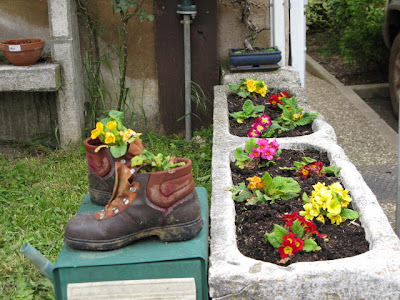Hello, everybody, and welcome again to Cépage et Cuisine, Mary’s and Brian’s wine and food blog. We’re continuing with our wine, food, and cultural experience in Burgundy. Today was a lazy Sunday with no appointments.
I ventured out while Mary was still sleeping and took this photo of the Chapelle Notre Dame de Bonheur just outside Magny-les-Villers on the road to Villers-la-Faye. The two villages are separated by less than a half mile.
This little chapel, about
the size of a couple of phone booths with a name that is translated roughly to
the Chapel of Our Lady of Happiness, is from either the twelfth or fifteenth
century, making it somewhere in the range of 600-900 years old.
I’m unable to learn whether it was part of an
actual chapel that was a place of worship or whether it is simply a roadside
chapel that provided comfort for reflection and brief shelter to those who
traveled among the villages in those years.
Either way, there it is, out there on the short road between these two
very small Burgundy towns. We think it is
beautiful and part of the charm of this area.
There is a small
brasserie in Nuits-Saint-Georges that we have visited for lunch every
year. We took a chance to see if it
would be open on Sunday and, lucky us, it was.
They make a salad that Mary loves called salade montagne, or mountain salad.
Bibb lettuce, walnuts, Emmenthal, a hard cheese similar to Gruyére, warm
potato slices, haricot vert, and a
Dijon mustard vinaigrette.

The accompanying house wine is a simple, unlabeled rosé from the Languedoc region in southwestern France.
Here’s another view of
the main street in Nuits-Saint-Georges.
Other than Dijon, Nuits-Saint-Georges is the largest town in the
northern Côte d’Or, called the Côte de Nuits.
The southern half of the Côte d’Or is called the Côte de Beaune for the
same reason, Beaune is the largest town in the southern part.
After lunch, we went to
Beaune to pick up some regional highway maps and post cards. I wanted to browse some art galleries, but
they were all closed. I did snap this
photo of the Marché aux Vins, the
wine market, which is an often-photographed image of Beaune.
Earlier, Marie suggested we visit an auberge, a hillside inn in the nearby
town of Bouilland for lunch or dinner during our stay. With no other agenda for the day, we drove
toward Bouilland to simply enjoy the countryside.
Bouilland turned out to be stunningly beautiful. It is nestled in a narrow valley of perhaps less than a half-mile across and with high mountain ridges on each side.
The east side has these enormous limestone cliffs.
The terrain reminds me
very much of the hilly, mountainous topography of north Georgia and east
Tennessee with its lush, green vegetation and peaceful beauty.
From the hillside above
the main road, the view across the valley reveals beautiful carpets of blooming
canola ...
... and grazing Charolais.
... and grazing Charolais.
A rushing creek that comes down from the mountainside flows through the middle of Bouilland. A short video of the creek is at the top of the blog post.
L’église is perched on the steep hillside with a view of the entire village.
Within its old stone walls around the church, it is completely surrounded by its cimetière.
An entire family plot can be within the space that Americans would often associate with a single grave.
The ossuaire, an ossuary, is an interesting part of the cemetery. Skeletal remains from old graves are collected and placed in the ossuary to save space for more graves.
I thought this grave was interesting. The marker is leaning precariously.
With a closer look you can see that Emile Serrigny died in World War I in the Alsace region. Mort pour la France is translated to “died for France.”
North of Bouilland we
encountered vast fields of canola. May
is the blooming season for this widely planted crop. Plots of it are plainly visible on approach for
landing in Paris and throughout rural regions of this part of France.
Here’s a photo of Mary in the canola to give
you perspective on how high it grows and how far it stretches beyond her in
this particular place.
Mary really is
out standing in her field!
Dinner back at the gite was the preserved cassoulet we
bought at the Marché Gourmand
yesterday. Cassoulet is a dish that can
be prepared in almost limitless ways, but the common ingredients are white
beans, usually duck, sausage, and a savory stock. This was literally a heat and serve
dinner. The seal on the jar was released
by pulling on the rubber ring, then the jar placed in a pot of boiling water
for 15 minutes. Voilà! There you have
it! Not all that fancy…just plain good
eating.
The wine was Claire Naudin’s Domaine Henri Naudin-Ferrand Ladoix La Corvée premier cru 2010. This vineyard is just down the hill from us and next to the boulangerie where I get Mary’s morning croissant. The wine was very young, but it had a nice, smooth texture and balance, aromas of earth and red fruit, fresh acidity for pairing with savory food, and bright red cherry and berry flavors. Of course, locally produced wine and food, consumed right here in Magny-les-Villers, makes it all taste better.
That’s our post for
today. Thanks for reading us and let us
know how you like the blog. Tomorrow is
Chablis day, so check back at Cépage et Cuisine for more on our France travels.
In the meantime,
Cheers!
Mary♥Brian


























No comments:
Post a Comment